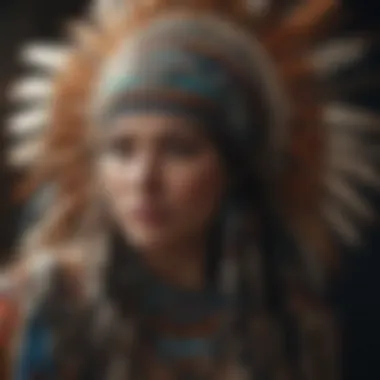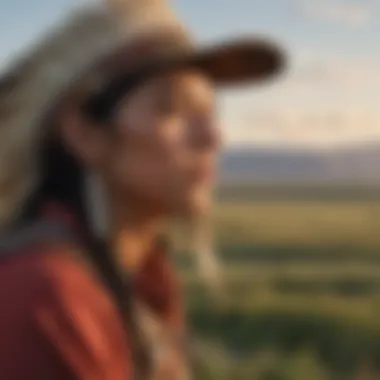Heritage of Native American Tribes in North Dakota


Nature Topic Overview
When we think about North Dakota, it might be easy to picture the vast landscapes and striking natural beauty. However, there's much more beneath the surface—particularly when looking at the rich heritage of Native American tribes in the region. Understanding their history, traditions, and languages further enriches our respect for this land. Native Americans have lived in North Dakota for thousands of years, blending their culture with nature and establishing a deep connection with the earth. This article aims to unfold the various facets of Native American life in North Dakota so that young readers, parents, teachers, and caregivers can gain a deeper appreciation for this significant part of our shared heritage.
The tribes in North Dakota, such as the Sioux, Mandan, Hidatsa, and Arikara, each possess unique customs and stories. Their languages, ceremonies, and art reflect their connection to the land and the natural world. Learning about these tribes helps to counter stereotypes and build a more sincere narrative, one that highlights resilience and cultural richness, all while facing various modern challenges. Through understanding comes the possibility of respect and, ultimately, a better bond with the environment that sustains us all.
Fun Facts and Trivia
Here are some intriguing tidbits about Native American tribes in North Dakota that will surely spark curiosity among young minds:
- The Origin of Names: Did you know that many place names in North Dakota have Native American origins? For instance, the name "Turtle Mountain" comes from the Ojibwe language, connecting the land to its original people.
- Historical Figures: One well-known figure is Sitting Bull, a Hunkpapa Lakota leader. His bravery and leadership during the Battle of Little Bighorn become legendary, reminding us of the fighting spirit of Native American leaders.
- Cultural Events: The annual North Dakota Indian Cultural History Days celebrates native heritage through storytelling, dance, and traditional crafts, showcasing the lively cultures of the tribes.
"Cherishing the past is a vital piece of understanding one's identity today."
Visual elements such as maps showing tribal lands and pictures of traditional regalia can enhance learning further.
Wildlife Explorations
Native American tribes' connection to nature is not just via culture, but also through their understanding of wildlife. The Great Plains are home to many fascinating species that tribes have coexisted with for generations. Some notable wildlife include:
- American Bison: Central to the Plains tribes' way of life; they were used for food, clothing, and shelter.
- Bald Eagle: A symbol of strength and bravery in many tribes, its feathers hold cultural significance.
- Prairie Dog: Considered a vital member of the prairie ecosystem, they are also a food source for many animals.
Quiz time! Can you think of which animals were crucial for Native American survival?
Environmental Awareness
Conservation efforts are deeply rooted in Native American culture. These tribes practiced sustainable living long before modern environmental movements took off. Young learners can explore ways to help protect nature:
- Participate in local clean-up days to help keep parks neat and beautiful.
- Learn about native plants to understand better their importance in the ecosystem.
- Engage in storytelling with family to share the wisdom of caring for the earth.
Being stewards of the land is not just a concept but a way of life that can be carried forward to new generations.
DIY Nature Activities
Getting hands-on can make learning about Native American heritage extra fun! Here are some engaging ideas:
- Create Your Own Nature Mandala: Use leaves, flowers, and other natural elements to make a colorful mandala reflecting the beauty of the environment.
- Story Stones: Find smooth stones and paint symbols or images representing traditional stories. Use these stones to inspire storytelling sessions with friends and family.
- Outdoor Treasure Hunt: Organize a scavenger hunt to find items related to local wildlife or plants, pinpointing their ecological roles in the environment.
Taking part in these activities not only fosters learning but also cultivates a love for nature and Native American traditions that can shape a brighter future.
Foreword to Native American Tribes in North Dakota
Understanding the Native American tribes in North Dakota isn't just about history; it's about appreciating a rich cultural legacy that continues to thrive today. Various tribes, each with their own unique stories, traditions, and languages, have shaped the identity of this diverse region. The indigenous population plays a vital role in America’s broader narrative, and North Dakota is no exception.
By exploring this topic, we uncover how these tribes have adapted over time while remaining deeply connected to their ancestral roots. It opens a window to see society through a lens that values community, respect for nature, and spirituality. Each tribe tells a story of resilience, wisdom, and creativity that can all inspire us.
Delving deeper into the heritage of Native American tribes also helps us understand their significance in today’s world. These tribes face modern challenges yet continue cultural preservation efforts that enrich not just tribal members but also the entire community.
Overview of North Dakota's Indigenous Population
North Dakota is home to several recognized tribes, each contributing to the state’s rich tapestry. The Standing Rock Sioux Tribe, the Mandan, Hidatsa, and Arikara Nation, as well as the Turtle Mountain Band of Chippewa, are some of the prominent groups.
- Standing Rock Sioux Tribe: Occupying a vast area near the borders of North and South Dakota, they have a powerful story intertwined with the struggle for land and rights.
- Mandan, Hidatsa, and Arikara Nation: These three tribes share a historical bond. They were known for their farming skills and their connections to the earth, which is reflected in their cultural practices.
- Turtle Mountain Band of Chippewa: With a significant presence in the northern part of the state, they contribute to the cultural mosaic through their art and traditions.
This diverse group stretches back thousands of years, encompassing a vibrant cultural landscape filled with myriad languages, stories, and traditions. The indigenous population, though facing numerous hurdles, continues to thrive and maintain its identity.
"The strength of Native American tribes lies in their ability to adapt and evolve, all while staying true to their roots."
Through this exploration, readers will gain not only knowledge but also the understanding that these tribes are dynamic entities actively shaping their future.
Historical Background
Understanding the historical context of Native American tribes in North Dakota is crucial in appreciating their rich heritage today. The historical background allows us to see how these communities shaped their environment and the challenges they faced over the centuries. This section sheds light on their early societies and how European colonization impacted their way of life, highlighting the resilience and adaptability of these tribes.
Early Inhabitants and Their Societies
Long before roads and buildings crossed the plains of North Dakota, the land was alive with the voices of its first inhabitants. Tribes such as the Mandan, Hidatsa, Arikara, and the Sioux, each had distinct traditions and ways of life carved from the heart of the land.
- Mandan Tribe: Renowned for their agricultural skills, they built earthlodges along the banks of the Missouri River. Their farming practices were advanced, growing crops like corn, beans, and squash, which they referred to as the “Three Sisters.” The Mandan also had a vibrant social structure, engaging in trade with other tribes and later with European settlers.
- Hidatsa Tribe: Close kin to the Mandan, the Hidatsa were expert hunters and gatherers. They lived in similar dwellings and were known for their deep spiritual connections to the rivers and hills that surrounded them. Their intricate dances and storytelling kept their history alive, sharing tales of bravery and challenges faced long ago.
- Arikara Tribe: This tribe was known for their unique housing structures called "framed houses” and their contributions to agriculture. They thrived on hunting buffalo and cultivated crops as well. Cultural practices such as the sun dance were important rituals that defined their social identity.


These tribes showcased a sophisticated understanding of their environment as they lived symbiotically with nature. Each tribe brought something unique to the cultural tapestry of North Dakota, creating a diverse and intertwined heritage that is still visible today.
Impact of European Settlers
The arrival of European settlers marked a turning point in the history of Native American tribes. Initially, there was some cooperation, with traders and settlers obtaining furs and agricultural goods from the tribes. But as time marched on, the dynamics shifted drastically.
The settlers brought with them ideals of land ownership that clashed with the tribal understanding of land as a communal resource. This led to significant land loss for Native Americans. Some key impacts include:
- Displacement: Many Native Americans were forcibly removed from their ancestral lands. The Treaty of Fort Laramie in 1851 was one such agreement that promised land to the tribes, but it was soon broken, leading to further loss of territory.
- Cultural Erosion: As settlers moved westward, there was a push to assimilate Native Americans into European ways of life. Schools, such as the Carlisle Indian Industrial School, aimed to erase Indigenous languages and customs. This had a long-lasting impact on tribal identities.
- Conflict: Increased tensions often escalated to violent confrontations, such as the Battle of the Little Bighorn. Such events demonstrated the desperation of the tribes to defend their way of life, yet they often faced overwhelming odds against well-armed settlers and soldiers.
Diverse Tribes of North Dakota
North Dakota is a land rich in cultural diversity, home to several Native American tribes whose histories and traditions are woven into the very fabric of the state’s identity. Understanding the Diverse Tribes of North Dakota is vital, as it tells us not just about the past but also about how these tribes shape the present and future. These tribes add a unique flavor to the tapestry of American culture, showcasing a spectrum of languages, beliefs, and practices that have stood the test of time.
The Mandan Tribe
Cultural Practices
The Mandan Tribe, rooted in North Dakota’s history, exemplifies resilience through their cultural practices. Their famous earth lodges, constructed from soil, grass, and wood, served as homes that kept warmth during harsh winters and cool during the hot summers. Right from their intricate farming methods, which included the cultivation of corn, beans, and squash, to their social gatherings that emphasized community bonds, the Mandan people’s culture reflects sustainable living.
These practices demonstrate not just survival, but a deep respect for nature, positioning them as role models for ongoing efforts in ecological conservation and cultural preservation.
"The Mandan’s connection to their land and community practices represents a symbiosis that is both enlightening and necessary in today’s world."
Legacy and Significance
The legacy of the Mandan Tribe lies in their historical narratives and traditions. Known for their unparalleled craftsmanship in pottery and beadwork, the Mandans contributed significantly to North Dakota's artistic heritage. Their rituals and oral stories—painted on rock and told by firelight—are vessels of wisdom passed down through generations.
This legacy provides cultural continuity, serving as a cornerstone for educational initiatives aimed at preserving Indigenous knowledge and inspiring future generations to embrace their roots.
The Hidatsa Tribe
Language and Traditions
The Hidatsa Tribe brings to the forefront a rich tapestry of language and traditions. Their language, which is still spoken by some members today, holds unique concepts and views of the world, emphasizing the relationship between people and nature. The Hidatsa language is more than just words; it embodies a way of life, enriched by storytelling and oral traditions that communicate values and community cohesion.
Efforts to teach the younger generation these languages are significant in keeping their heritage alive, bridging gaps between the past and the future, ensuring that their essence is not lost.
Historical Significance
In terms of historical significance, the Hidatsa played a pivotal role in regional history, particularly during pivotal moments like the fur trade era. Their strategic trading relations withEuropean settlers enriched their community and provided them with goods that enhanced their quality of life. Understanding the historical circumstances surrounding the Hidatsa arms us with insights into the importance of adaptability and negotiation.
The Arikara Tribe
Social Structure
When one looks at the social structure of the Arikara Tribe, it becomes clear that kinship and community are at the heart of their society. Extended families formed the core of their social fabric, with relationships dictating not just everyday life but cultural norms and practices. Women often held significant sway within this structure, overseeing not only domestic spheres but also influencing community decisions.
This dynamic is vital for understanding how gender roles can vary among tribes, offering broader perspectives on social organization.
Cultural Contributions
The cultural contributions of the Arikara people stretch far and wide. Known for their unique basket weaving and intricate art, the Arikara have shared their craftsmanship widely. They’ve taught neighboring tribes and settlers the art of making everyday items beautiful and functional. This exchange enriches North Dakota's collective identity as a region enriched by a blend of artistic influences.
The Sioux Nation
Subdivisions and Dialects
The Sioux Nation comprises various subdivisions, each with its own distinct dialects and identities. The dialects not only mark linguistic diversity but also represent a multitude of cultural nuances. By engaging with these different dialects, one can gain a better understanding of the identities and traditions that make up the rich heritage of the Sioux people.
Historical Events
Throughout history, the Sioux have faced numerous challenges, including conflicts and treaties that shaped their present existence. Important historical events, such as the Battle of Little Bighorn and the Wounded Knee Massacre, mark the struggle for sovereignty and identity, which remain poignant topics in contemporary discussions around Native American rights and histories.
These events not only connote significant struggles but also reflect resilience and the fight for recognition and justice, making the Sioux a vital part of North Dakota's story.
Language and Communication
Language plays a vital role in the life and culture of Native American tribes in North Dakota. It’s not just a means of communication; it’s the very essence of identity, heritage, and connection to the land. For young learners, understanding why language matters can help bridge gaps between generations and emphasize the rich traditions that persist. This section will dive into the languages used by these tribes and explore efforts to keep them alive.
Languages of Native American Tribes
Preservation of Indigenous Languages
Preservation of Indigenous languages is crucial. Many tribes, like the Mandan, Hidatsa, and Arikara, have languages that are not only part of their day-to-day life but also encapsulate their stories, beliefs, and values. When a language fades, it takes with it the wisdom of its speakers. It is like losing a gallery of art that has shaped the tribe's existence.
One key characteristic of preserving these languages is the focus on storytelling. Languages in many Native American cultures thrive on oral traditions—the stories connecting them to their ancestors. This characteristic makes preserving Indigenous languages particularly beneficial because it keeps alive the richness of their cultural narratives. The unique feature of language preservation lies in its community aspect, where the whole tribe often plays a part in teaching and passing it down.
However, the challenge is that fewer young people are speaking their native tongues. This can lead to a loss of deep connection to their heritage and identity. Therefore, efforts to revive these languages are gaining ground, such as community classes and resources. The advantages of language preservation not only enrich the tribes; they contribute positively to broader society by promoting cultural diversity.


Teaching Youth
Teaching youth the languages of their ancestors is another crucial aim in Native American communities. Early exposure to one’s heritage language ensures that the next generation can connect with their roots. Cultivating this connection is not only about learning words; it’s about fostering a sense of belonging and identity.
The emphasis on teaching youth these languages allows kids to see their culture in a new light. A key characteristic of this approach is making learning interactive and fun. Activities often include traditional songs, games, and storytelling sessions that children can enjoy and remember. The unique feature of teaching youth in a culturally immersive environment is that it instills pride in their identity.
While teaching youth is beneficial, it also faces hurdles. Modern distractions, like digital devices, can pull attention from cultural practices. However, the combined efforts of parents, teachers, and community leaders to engage youth in measurable ways can counter this.
"A language is something infinitely greater than grammar and philology. It is the poetic testament of the genius of a race and the entire history of the individual." - Otto Jespersen
In summary, both the preservation of Indigenous languages and teaching youth about their heritage are essential. They not only emphasize cultural identity but also contribute significantly to the resilience of Native American tribes in North Dakota. Understanding them can illuminate pathways for young learners and offer a broader perspective on the world around them.
Cultural Practices and Beliefs
Cultural practices and beliefs are the backbone of Native American life in North Dakota. They shape identities, community ties, and individual worldviews. By examining these intricate practices, we gain insight into not just a way of life, but a rich tapestry woven with history, respect for nature, and deep spirituality. Native American tribes in this region have cultivated customs that express their connection to the land and their heritage, and understanding these traditions allows us to appreciate their significance.
Traditional Ceremonies
Traditional ceremonies play an essential role in the lives of Native American tribes. They often mark important life events such as births, marriages, and deaths. These rituals are not merely social gatherings but are profound spiritual observances aimed at connecting participants to their ancestors, their community, and their environment.
One notable ceremony is the Sun Dance, practiced by several tribes, including the Sioux. This sacred event involves dance, fasting, and sometimes physical endurance, all done to honor the Creator and seek visions that provide guidance.
Another meaningful ceremony is the Potlatch, which is characterized by feasting, dancing, and gifting. It emphasizes communal ties and is a statement of social status within the tribe. Potlatches are not just celebrations; they serve to redistribute wealth and strengthen community bonds.
"Ceremonies serve as a time space where memory links to action, making the past a living part of the present."
Spiritual Connections to Nature
For Native American tribes, the connection to nature is deeply spiritual. Many believe that everything in the natural world—be it animals, plants, or celestial bodies—has a spirit and that humans are a part of this interconnected web. This belief influences their practices, from hunting to agriculture.
Tribes often view themselves as guardians of the earth, promoting sustainable practices that respect the environment. For example, the Hidatsa people's traditional farming methods are designed to nurture the land rather than exploit it. They plant seeds according to lunar cycles, understanding that the natural world offers wisdom that must be heeded.
Furthermore, nature itself is often an important character in their stories and teachings. Through oral traditions, children learn about the significance of elements like the buffalo, which is not only a source of sustenance but a symbol of strength and resilience.
Understanding these connections offers children and adults alike a perspective on environmental stewardship and encourages respect for the world around them. This perspective underscores the importance of indigenous knowledge as a vital resource for contemporary environmental issues.
Art and Expression
Art and expression play a vital role in the lives of Native American tribes in North Dakota. They don’t just create art for beauty’s sake; their work reflects their history, beliefs, and their connection to the land. Art serves as a bridge that connects generations, enabling younger members to understand their heritage and the teachings of their ancestors.
Expressions through various art forms also foster a sense of unity within the community. The act of creating together can strengthen relationships among family and friends, turning simple art-making into a cultural gathering. Moreover, showcasing these arts can educate others about Native American traditions, inviting appreciation and respect for their culture.
Traditional Art Forms
Pottery
Pottery is a significant art form among Native American tribes, especially in North Dakota. It’s more than just a practical skill; pottery-making embodies traditions, storytelling, and identity. Many potters use techniques passed down through generations, creating pieces that are not only functional but also unique works of art. The key characteristic of pottery is its ability to reflect the earthiness and natural textures that resonate with Native American ties to the land.
The benefit of including pottery in this discussion is that it highlights both creativity and heritage. Each pot tells a story, showcasing the techniques and materials traditionally used, which are embedded with cultural significance. However, the unique feature of pottery lies in its fragility; while they are beautiful, these pieces can be easily broken if not respected.
Beadwork
Beadwork is another important aspect of Native American art in North Dakota. This intricate form of expression involves threading beads into beautiful designs on items such as clothing, accessories, and ceremonial artifacts. What makes beadwork particularly captivating is the variety of styles and techniques, which may differ from tribe to tribe.
The key characteristic of beadwork is its personal nature. Every bead can carry meanings, colors often symbolize particular stories or emotions, making each piece distinctively individual. In this article, the focus on beadwork highlights how art is tied deeply to identity and cultural expression, making it a popular choice to illustrate Native American creativity. However, the time-consuming nature of beadwork requires substantial commitment, which can be both an advantage for sharing patience and focus or a disadvantage if someone seeks quicker artistic endeavors.
Textiles
Textiles are another significant water in the world of art for Native American tribes. The creation of woven materials, like blankets and clothing, involves skill and deep cultural knowledge. Each design woven into the fabric can carry deep cultural stories or reflect the natural world.
The key characteristic of textiles lies in their functionality. Unlike many other art forms, textiles serve practical purposes—keeping one warm, providing shelter, or becoming part of ceremonial presentations.
By including textiles in this article, we further emphasize how Native American arts are not solely decorative but integral to daily life and cultural tradition. Their unique feature is their ability to blend utility with artistry. However, creating textiles can be a more lengthy endeavor and requires access to materials which might not be available to everyone today.
As such, each of these art forms—pottery, beadwork, and textiles—not only enriches the cultural landscape of Native American tribes in North Dakota, but they also offer vital insights into their rich heritage, serving as a reminder of their resilience and creativity.
Contemporary Issues Facing Native Americans
In today's world, Native American tribes find themselves facing a mix of challenges that resonate deeply with their past and influence their future. Understanding these contemporary issues helps us grasp the resilience of these communities as they navigate a complex landscape of economic, cultural, and social dynamics. Addressing these challenges is crucial not only for the tribes but also for fostering awareness and understanding among wider audiences.
Economic Challenges
Economic hardship looms large over many Native American communities. High unemployment rates, lack of access to quality education, and limited job opportunities create a challenging environment for young people and families alike. Many reservations are located in remote areas, making it even tougher to tap into larger economic networks.
- Resources Allocation: Government funding often falls short, affecting crucial services from healthcare to education.
- Sustainable Enterprises: While some tribes have begun to explore avenues like tourism and gaming to bolster their economies, the benefits are not always evenly distributed. This can lead to tensions within the tribal community.
Despite these hurdles, many tribes are gaining traction through innovative strategies. Some examples include investing in renewable energy projects, which not only provide jobs but also promote sustainability.


"Economic empowerment is vital for tribes to thrive in today's society, but it takes more than just a plan on paper to make it work."
Cultural Preservation Efforts
Cultural preservation stands at the heart of Native American identity. As modern influences seep into traditional ways of life, tribes are increasingly focused on keeping their languages, stories, and ceremonies alive. This mission is fundamental in ensuring their heritage is passed on to future generations.
- Language Revitalization Programs: Many tribes are working hard to revitalize their languages, often involving immersive programs in schools where children learn through activities and interaction. The language is more than just words; it carries stories and perspectives unique to each tribe.
- Support from Elders: Elders play a pivotal role in teaching younger generations about traditions and histories. Their wisdom is a linchpin in cultural connectivity.
Efforts like cultural gatherings, workshops, and educational camps are becoming more common, aiming to instill pride and knowledge among the youth.
By combining traditional practices with modern platforms, such as social media, tribes are expanding their reach and impact. Through these initiatives, they’re not only preserving their vibrant culture but also inviting others to share in the experience, ensuring that their legacies endure.
Contributions to Environmental Conservation
Understanding how Native American tribes in North Dakota contribute to environmental conservation is pivotal for grasping their role in sustaining the earth and its resources. These tribes stand as guardians of nature, often blending ancient wisdom with modern practices to foster a deep-rooted connection to the land.
Traditional Ecological Knowledge
Traditional Ecological Knowledge (TEK) is a term that refers to the understandings, skills, and philosophies that indigenous people accumulate over generations through direct contact with the environment. This knowledge is not just practical; it’s a way of life that influences their cultural practices.
TAKE A CLOSER LOOK AT TEK:
- Food Sources: North Dakota tribes, such as the Mandan and Sioux, have extensive knowledge of local plants and wildlife. They know which plants are good for food and medicine, and how to hunt and fish sustainably.
- Land Management: The tribes often use controlled burns to manage the land, which promotes growth of certain plants and reduces the chances of larger wildfires. This practice shows a balance of respect for nature and an understanding of ecological systems.
- Water Conservation: Many tribes see water as sacred. Their understanding of water cycles and the importance of preserving clean water bodies has led to initiatives that promote sustainable farming and fishing practices, which not only benefit the tribes but the surrounding community too.
"Knowledge handed down through generations is more than just facts; it is a way to live in harmony with nature."
Enhancing Biodiversity
The contributions of tribes to biodiversity reflect their belief in the interconnectedness of all living things. Through their stewardship, Native Americans have maintained a vast array of plants and animals, ensuring their survival for future generations. For example:
- Seed Preservation: Many tribes have included the preservation of heirloom seeds in their conservation efforts. This not only keeps traditional crops like maize or wild rice alive but also supports biodiversity.
- Cultural Practices: Festivals and ceremonies that revolve around planting and harvesting are integral to many tribes. These events reaffirm their commitment to the earth and encourage younger generations to appreciate environmental stewardship.
Collaboration with Scientists
In recent years, tribes have teamed up with scientists and environmental organizations. This partnership combines TEK with scientific research to create effective conservation strategies. Here are some alliances:
- Restoration Projects: Tribes participate in restoring habitats that have been degraded, using both their traditional practices and modern science.
- Climate Change Awareness: Many initiatives work to address the impacts of climate change, blending indigenous perspectives with contemporary scientific findings.
- Educational Workshops: These efforts often include workshops where tribal elders teach young people about the land, traditions, and environmental responsibility.
Ultimately, the contributions of Native American tribes to environmental conservation in North Dakota exemplify a harmonious relationship with nature. Through TEK and active stewardship, they embody principles of respect, responsibility, and reciprocal care for the earth, ensuring that their heritage and the planet thrive together.
Education and Outreach
Education and outreach are crucial elements in the realm of Native American heritage. These initiatives are not just about sharing knowledge; they also work to connect young people with their cultural roots. Engaging the youth is like planting seeds in a garden. If nurtured with love and care, these seeds grow into strong, resilient plants. In terms of Native American tribes, this means understanding and preserving the rich history and culture for future generations.
For children aged 5-12 years, education about Native American tribes can lay a foundation of respect for different cultures. It opens windows that can lead to understanding, empathy, and appreciation for diverse lifestyles. This education can come through various methods such as storytelling, workshops, and hands-on activities that illustrate traditional practices.
Why is it essential to focus on programs for youth engagement? Consider the following points:
- Cultural Awareness: Youth programs foster an understanding of Native American history. They help children see that these aren't just tales from the past; they are living histories.
- Identity Formation: Programs that highlight cultural practices allow young people to explore their identities. They learn not only about their heritage but also about the environment around them.
- Sustaining Traditions: Young minds are like blank canvases. When they engage with traditional art, stories, or music, they help keep culture alive. This is important for the tribes to continue their way of life.
- Community Bonds: Participating in programs enhances social skills. Kids learn to work together, share, and support one another. It builds a sense of community that transcends age, background, and experiences.
Moreover, education about Native American tribes promotes environmental stewardship. Many programs emphasize the importance of nature and the interconnectedness of life. This understanding can shape how young people view the environment, leading to responsible future citizens who care for their planet.
"Teaching the young about our ancestors and respecting nature is the best gift we can give them. They are the future, and their hearts hold the key to our culture's survival."
— A modern-day member of the Mandan tribe
Programs for Youth Engagement
There's a bouquet of programs dedicated to engaging youth in Native American culture. Here are some examples that stand out:
- Storytelling Workshops: These workshops bring traditional tales to life. Young participants get to hear stories passed down through generations, discovering moral lessons tucked inside each tale.
- Cultural Festivals: Events like the North Dakota Indian Cultural Celebration offer hands-on experiences. Kids can try native foods, traditional dances, and learn about crafts like beadwork or pottery.
- Nature Exploration Programs: Just as tribes have deep connections to the land, programs often teach children about local flora and fauna, emphasizing sustainable practices.
- Art Classes: These classes allow children to express their creativity while learning traditional art techniques.
- Mentorship Programs: Connecting youth with tribal elders not only helps pass down knowledge but also strengthens community ties. Mentors inspire the younger generation while sharing valuable life lessons.
Ultimately, education and outreach serve as bridges linking history and modern experiences. By engaging young people with their Native American heritage, we pave the way for a future full of respect, understanding, and cultural richness. This blend of the past with forward-thinking ensures that both the knowledge and spirit of Native American tribes thrive.
Culmination
Reflecting on the past is not just a mere glance over history; it is about finding meaning and understanding how it shapes our present and future. The rich heritage of Native American tribes in North Dakota offers invaluable lessons that, when learned, can inform how we approach various contemporary issues.
Reflecting on the Past to Shape the Future
Examining the stories of tribes like the Mandan, Hidatsa, and Sioux reveals a tapestry woven with resilience and adaptation. Their survival amid challenges like the encroachment of European settlers showcases an impressive spirit of endurance. The traditions and practices of these tribes provide a window to sustainable living that can guide us today. For instance, their deep connections to the land echo in modern conversations about environmental stewardship.
As we reflect on these histories, we also uncover a framework for future relationships, whether they be among communities or with nature itself. One important takeaway is the emphasis on community, which resonates with how we can build inclusive societies. The collaborative efforts seen in traditional ceremonies are a powerful reminder of unity—teaching young people the value of working together for shared goals.
Moreover, this reflection encourages curiosity and respect for cultural diversity. Today’s youth are tomorrow's leaders, and by understanding the past, they stand a better chance of nurturing a more harmonious world. The younger generation can harness the invaluable lessons of Native American tribes, embracing the ecological wisdom found in their traditions.
Their approach to education, where the elders pass down knowledge, can inspire current educational frameworks to integrate similar methods. Thus, promoting respect for all cultures, the wisdom of the land, and the importance of history will lay a foundation not only for personal growth but also for peaceful coexistence.
"Understanding where we come from is essential for knowing where we are going."







